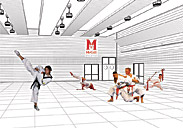Expansion planned for McGill's gym
Expansion planned for McGill's gym McGill University
User Tools (skip):
Expansion planned for McGill's gym
If you find the fitness centre at the Currie Gym a bit too cosy for comfort of late, fear not. Not only do crowds tend to thin as New Year's resolutions recede in memory, but major renovations scheduled to start in March will, among other things, double the size of the fitness centre to 10,000 square feet.

Proposed combatives room at sports centre
Werleman Guy McMahon Architectes
And the gym calendar to be distributed next August should excite all gym members' meditative, competitive or combative impulses with more courses in martial arts, yoga and spinning, making it all the more likely that our resolutions for 2005 will be met and carried into 2006.
Construction should be completed by September. Members' workouts will be mostly uninterrupted, though when the new space is merged with the existing fitness centre in the early summer, the gym will close for a week or two.
Two new multi-purpose rooms, one with a "sprung" hardwood floor, and another with tatami mats for martial arts, will allow for a host of new courses for the 2005—2006 school year.
Along with martial arts enthusiasts, golfers will have something to smile about. According to the director of the Athletics Depart-ment, Bob Dubeau, there was enough interest in golf from the student body and other members of the McGill community to call for construction of five individual practice ranges and a putting green.
Plans for a rock-climbing wall had to be postponed, as the university needs the space to store homeless archival material. But Dubeau is quick to point out that this arrangement is temporary. Once the archives find a permanent home, if the competitive drive of gym members is not satisfied with putting, they will eventually have the option of literally clawing their way to the top.
Better circulation in currently crowded locker rooms will be guaranteed, thanks to 6,000 coed basket lockers for permanent equipment storage. Men's and women's basketball teams will finally have their own locker rooms. The coaches who have been tucked away in a windowless space that was once a rifle range will have new offices and a conference room.
The project was significantly bolstered when the student body resolved in a referendum to offer financial backing. The university then agreed to match the students' contribution of $1.95 million. This leaves $1 million (half of which is already in hand) to be raised through donations. "We have some donations we've received for the teams' rooms, the [coaches'] offices and the conference room," says Dubeau. There are still some naming opportunities open — notably for the golfing area — to interested supporters of McGill Athletics.
The original plan was to have the project completed within the 2004—2005 school year. But project costs that climbed from the original estimated $3.6 million to $5 million resulted in a six-month delay. Explains Dubeau, "When the consultants and engineers dug into the plans room by room, square foot by square foot, they found that there was a lot more work that had to be done that hadn't been planned." The existing air conditioning system could not, it turned out, cope with the newly expanded area. That additional work alone resulted in an increase of a half-million dollars.
If this round of improvement will benefit the hale and hearty, within 18 months' time the next round of fundraising and renovations for the relocation of the Sports Medicine Clinic from the third to the main floor will offer relief for hobbling or otherwise injured athletes.
Arts student Matthew Howatt, who chaired the student referendum committee on the sports centre fee last year, says, "The director of Athletics did a great job of working with the university to overcome the higher-than-expected cost and ensure that the project will still be delivered in a timely fashion." The gym is oversubscribed, he points out, and the additional multi-disciplinary space is much needed.
Student contributions are part of an important legacy, says Howatt. "It's nice to know that this will benefit average students, athletes and coaches. This is part of a larger legacy."
